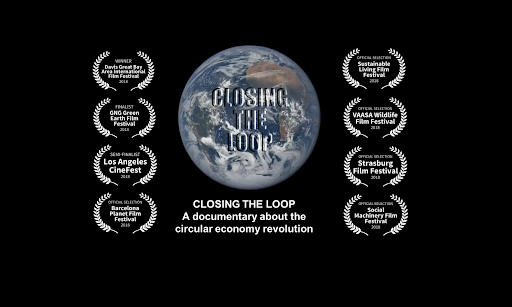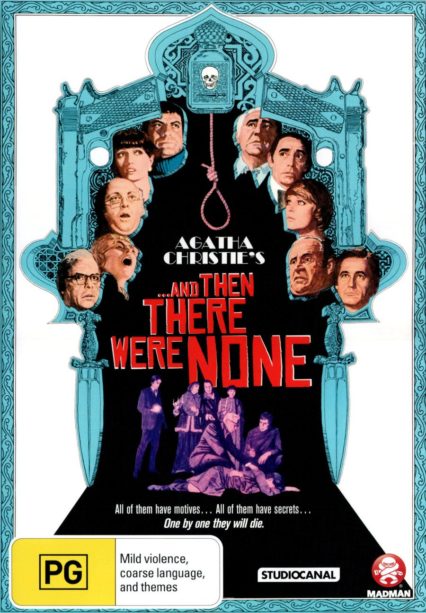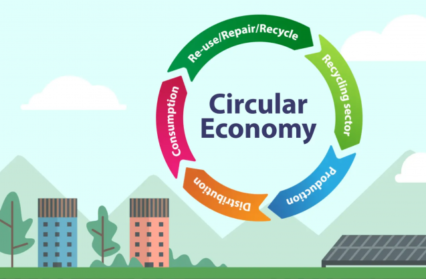Wales Arts Review is proud to present Arts and the Circular Economy, a new series of articles by Brian Royson Mayne, exploring the ways in which different art forms are promoting sustainability and embracing the circular economy. In this second article of the series, Brian Royson Mayne explores the ways in which theatre and film have incorporated principles of the circular economy into their work.
Across the theatre and film sector, companies are working towards reducing the environmental impact of their work and making it more sustainable. Theatres are hosting environmental awareness activities, performances and implementing sustainable methods of running a venue. Whereas the film industry in particular through the BFI is encouraging filmmakers to incorporate sustainable practices throughout production. Here I take a look at some of these activities and in particular how the sectors are moving beyond a ‘take, make, dispose’ economy and towards a circular economy, where all materials are treated as precious resources, with nothing thrown away.
The Welsh Government’s aim to be a zero waste, circular economy nation by 2050, will require us to keep products, components and materials in use as long as we can. It means that every sector, including the theatre and burgeoning film industry in Wales, will be required to make significant changes to meet this statutory target.
The film industry has taken major strides to implement the circular economy into their productions. The BFI commissioned, Green Matters Environmental sustainability and film production an overview of UK film production activity and environmental sustainability to help support the sector reach net zero. The research provides a snapshot of UK film production activity and the kinds of levers that could help change behaviour and increase sustainability in production. Also, BFI and BAFTA joined forces to launch A Screen New Deal – a Route Map to Sustainable Film Production, to help film production transition to net zero emissions by 2050. It sets out a blueprint for the film ecosystem, mapping out design and operational recommendations, providing information about the new services, materials and knowledge required to achieve more sustainable production as well as case studies showing how change is happening. Another case study on delivering sustainability is How to build and run a sustainable cinema, which can be found in a blog post by Natasha Padbury, the green ambassador for Lewes’ Depot, who claims to be one of the greenest cinemas in Europe.

There are also films that have been produced that promote the circular economy. The Ellen MacArthur Foundation film, a short Think Piece for children portrays a mad professor who questions our currently unsustainable attitudes towards resources, and he promotes a different approach based around ‘getting loopy’ and embracing a circular economy. And it’s not the first time film has been used to increase awareness of the circular economy, it was the subject of a feature-length documentary, Closing the Loop, which was publicly released on Earth Day, 22 April 2018 on Amazon and Vimeo.
Outside of film, there are examples of the circular economy and sustainability being promoted within the theatre sector. The National Theatre Wales has been proactive in this area for some time by submitting every decision they make through a rigorous sustainability test whether it be in programming, production, communications, or administration. They were responsible for the project Egin, a two-week residency in response to climate change, held in the Snowdonia National Park, which drew on the inspiring Welsh landscape and its complex social history, together with insight from active local communities. This is one of many examples of performances related to sustainability and in particular climate change that have been produced and taken place in Wales. Last year, a double bill of plays that premiered 10 years ago and were hailed as the first big theatre productions to tackle the climate crisis head-on, were revived in a co-production by the Donmar Warehouse and Theatr Clwyd.

One area the industry is at the forefront of the circular economy is by sharing, leasing, reusing, remanufacturing, repairing, refurbishing and recycling existing costumes, sets, props and equipment as long as they can, thereby prolonging the life cycle of a variety of items used in performances. Costumes in one production are often used in another. It is worth highlighting that costume design, like the rest of the clothing industry, relies on established materials and linear production methods with little regard for their impact on the environment or employees. Costume design and production are linked to the global fashion industry, which produces 8-10% of global CO2 emissions. Adoption of circular economy models through sustainable costume design and reuse therefore has a major role in contributing to reducing emissions.
There are also the venues that sustainability and the circular economy has been embedded. The construction of the Wales Millennium Centre used 2,000 tonnes of recycled Welsh slate, reclaimed from waste spoils for the exterior of the building. Tom Harper, director at Unusual Rigging and leading exponent of the circular economy has developed a list of suggestions on how his company incorporates circularity, such as ensuring unwanted resources taken from stripped out theatres are repurposed and used in new settings.
Companies such as DRESD, based in the Vale of Glamorgan who specialise in circular solutions for the waste streams developed in the creative industries; particularly film, TV and commercial events also play a valuable role. They provide a service that aims for a full circle of reuse, which includes storing, reusing and upcycling set elements to reduce waste within the industry. The company reclaims previously used sets, props and waste materials that would otherwise be disposed of and ensure they are used on future productions. This reuse of materials that would previously have been disposed of or destroyed, saves both money and resources. As well as supporting reuse and waste reduction, the service also demonstrates creativity and initiative in crafting effective props and sets from upcycled materials. The use of reused sets can be a form of entertainment in itself, YouTube is full of examples of sets and locations used time and again on old films.

There are also numerous instances of movies reusing footage from other films. It doesn’t stop there, even film scripts have been reused. Apart from changing the location from a snow mountain chalet in the Alps to a plush hotel in a desert in Iran, the director Harry Allan Tower’s 1974 film adaptation of the Agatha Christie mystery novel And Then There Were None, recycled the entire script, from an earlier 1965 film he had previously directed. However, perhaps the most famous piece of reuse in cinema is the sound effect known as the Wilhelm scream which has appeared in hundreds of films from the ’50s to now.
There are many other examples of the circular economy in action in theatre and film and importantly plenty of opportunities to save money and the planet. We all recognise that governments, businesses and individuals all need to take urgent action to tackle the environmental and climate emergency we face. At the heart of this environmental crisis is our production and consumption system which continues to extract more resources from our earth and at a faster pace than nature can replace them. The circular economy is a direct response to resource scarcity and the present linear economy, which involves the process of obtaining raw materials for manufacture transforming them into products that are distributed and purchased by consumers who end up throwing them away as waste. Theatres and films can by adopting the circular economy in the buildings, sets and productions support their sustainability ambitions and play their role in reducing and recirculating finite natural resources.
Our future depends on us protecting our environment and delivering a green recovery in response to the pandemic. To achieve this, we need to engage the public in understanding and supporting the issues and ways they can be addressed sustainably. Perhaps the last word in this series of articles should be a quote from the Art & Humanities Entrepreneurship Hub:
‘How do we as a society tackle the problem of achieving sustainability? That is the biggest long-term question facing us right now. The answer could be the ‘Circular Economy’, and the people to implement it are the non-linear creative thinkers of the Arts and Humanities’.
You might like…
In the first article of this series, Brian Royson Mayne introduces the subject and discusses the origin of the circular economy and how it is being defined today.
Brian Royson Mayne is a fellow of both the Royal Society of Arts and Chartered Institution of Wastes Management. He is a Chartered Environmentalist with extensive experience of working within the Circular Economy this has involved business development, providing advice to SMEs and Social Enterprises.












